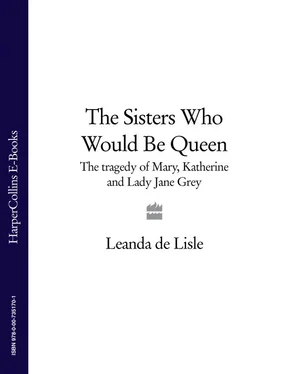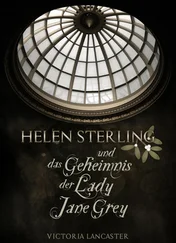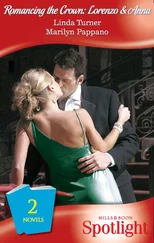* Salt was used in Catholic baptism until the 1960s: a small amount was placed on a baby’s lips as a symbol of purity and to ward off evil.
Some of Jane Grey’s first memories must have been of the magnificent family seat at Bradgate Manor in the Midlands, even if she was not born there. 1 It was the first unfortified house in Leicestershire, a palace of rose-red brick patterned in diamonds of deep lilac, that Dorset’s father and grandfather had built as an airy replacement for the ancient castle whose stones still lay nearby. The peace and order heralded with the advent of the Tudors meant everything about the house could be done with an eye to beauty or pleasure. In place of thick walls pierced by narrow openings, large mullioned windows let in the light and its towered wings marked the outer points of a welcoming U-shaped courtyard.
The family’s private rooms, including Jane’s bedchamber, and the cot she slept in as an infant, were in the west wing. There was a chapel where, as she grew older, she said her prayers, and a small kitchen. The west wing housed the servants’ hall, a bakery, brewery and the main kitchen, which was constantly busy. Her father entertained here generously and when he was in residence the house was packed with at least three dozen of his retainers as well as visitors and members of the extended family. For the most part the household ate together in the great hall, an 80-foot-long room in the centre of the house, kept warm by a large fireplace. There was a dais at one end, where the family ate in state and a gallery the other end where music was played.
Jane reached what was, in religious tradition, the age of reason, when she was seven. She was small for her age, but with a fiery character to match her reddish hair and a quick, articulate intelligence. She was said later by a contemporary to be her father’s favourite daughter. 2 She was certainly proving every inch his child. It was a time for her adult education to begin and a year later, in 1545, an impressive new tutor arrived to oversee her studies. John Aylmer had been introduced to Dorset when he was still only a schoolboy and the marquess had paid for his education until he graduated from Cambridge that year. He was a brilliant academic and had been picked by the marquess for his post over several other clever young men of whom he was patron.
Jane had also, by now, two younger sisters, whose adult education had yet to begin. The middle sister, Katherine, turned five that August, the same month their grandfather, Charles Brandon, Duke of Suffolk, died. 3 Affectionate and golden-haired, Katherine preferred her pets to Jane’s books, but she was the beauty of the sisters. In the limnings, or miniatures, painted by the court artist Lavina Teerlinc she resembles her lovely grandmother, the King’s late younger sister, Mary Tudor, the French Queen.
The youngest of the three sisters, Mary Grey, was still only a baby at this time and it may not yet have been apparent that there was anything wrong with her. But Mary was never to grow normally. As an adult she was described as the smallest person at court, ‘crook backed’ and ‘very ugly’. It has even been conjectured that she was a dwarf. Whatever the truth, Mary Grey had something of the best qualities of both her sisters, with Katherine’s warmth and Jane’s intelligence, as well as the strong spirit they all shared. If her parents were disappointed with her in any way, there is no record of it. 4
Life at Bradgate was idyllic for the sisters. There were extensive gardens for them to play in, as well as the great park, which was the glory of the house. A medieval village had been destroyed to create the illusion of a perfect wilderness covering several square miles at the edge of Charnwood Forest. Here was a place ‘more free from peril than the envious court’, where you could find ‘tongues in trees, books in the running brooks, Sermons in stones, and good in everything’. 5 The children could walk their father’s prize greyhounds, or accompany their mother and her friends as they hunted deer with longbow and arrows. 6 On rainy days there were also other amusements inside.
Dolls were popular toys of the period and the types the sisters enjoyed are described in a later inventory of items in Jane’s possession. ‘Two little babies in a box of wood, one of them having a gown of crimson satin, and the other a gown of white velvet.’ 7 Their parents were careful, however, not to spoil them. Over-indulgence was believed to make children physically and morally soft, with potentially disastrous results. Loving parents instilled discipline early with good manners considered essential. The girls were taught to stand straight and show respect to their elders, to speak only when they were spoken to and to respond promptly to commands. They had to eat nicely, observe the correct precedence at table and show gratitude for any praise they were given. At night, if their parents were at home, they would go to them to say goodnight and kneel to ask their blessing.
The duty of obedience was considered a particularly useful lesson for girls since they were expected to remain submissive to their husbands after they had left the care of their fathers. But the thinking on what women were capable of was changing. Baldassare Castiglione’s bestselling Book of the Courtier argued that women were as intelligent as men, and suggested they could learn to control their ‘emotional’ natures through the exercise of will and reason. A Grey family friend later translated the book into English. 8 In the meantime, other Englishmen such as Richard Hyrde were already promoting female education, and for a brief period that would end with the generation of the Grey sisters, the education of women remained fashionable. 9 Both Frances and Dorset were determined that their daughters would be given the opportunity to develop practical and intellectual skills of the highest order.
Of the former, the humble business of cooking and sewing remained important. Even noblewomen were expected to know something about the more expensive dishes created in their kitchen and to be able to make clothing. Frances sewed shirts and collars as New Year gifts for the King and her friend Lady Lisle’s quince marmalade was amongst her best-received presents to Henry, who liked it ‘wondrous well’. 10 As future courtiers the sisters also received regular lessons in dance and music: the lute, the spinet and the virginal were all popular choices of instrument for girls destined for court. But it was in the sisters’ academic studies that Lady Jane Grey, in particular, was to excel, with strong encouragement from her father.
Dorset had received a brilliant education in the household of the King’s illegitimate son, the late Henry Fitzroy, Duke of Richmond. He had learnt eloquent Latin from a pupil of Erasmus, and French from John Palsgrave, the greatest scholar of the language in England. It had left Dorset with a love of scholarship that was renowned during his lifetime and which he was determined to pass on to his children. As soon as his daughters had learned to read, write and understand basic mathematics they made a start in French and Italian. Over half a century later Dorset’s youngest daughter, Lady Mary Grey, still kept copies of Palsgrave’s French grammar and dictionary in her library, along with the Book of the Courtier and an Italian grammar. 11 By the age of eight Jane, and later Katherine, were also learning Latin and Greek, subjects that Aylmer was particularly well qualified to teach. A visitor to Bradgate, the radical divine Thomas Becon, described him as ‘singularly well learned in both’.
But Aylmer was much more than a mere language teacher. The point of education in the sixteenth century was not simply to learn to read, write and understand ancient languages. It was about moulding good subjects of God and the King. Jane and Katherine’s Greek and Latin were a means to help reinforce lessons of moral, social and religious truth indoctrinated from the cradle - literally so. The visitor, Becon, insisted that as soon as a child was capable of speaking in sentences they should be taught phrases such as: ‘Learn to die…’ 12 . Jane would, years later, repeat the phrase in her last letter to Katherine and reflect on its meaning. This was to be a good Christian in this world, and so to achieve the reward of absolute happiness with God in the next. Unfortunately, what it was to be a good Christian, and where the path to eternal life lay, remained a matter of lethal debate. Since Jane’s birth in 1537 new divisions had arisen between those, like the ideologue of the royal supremacy, Bishop Gardiner, who adhered to Henry’s Church but remained conservative in his core beliefs, and those who saw the King’s reformation as the gateway to more drastic change.
Читать дальше












